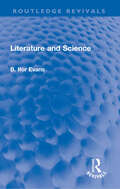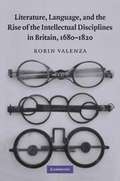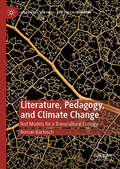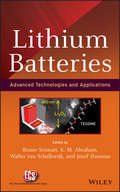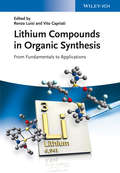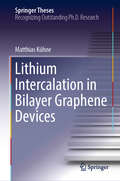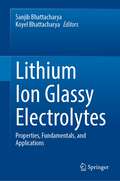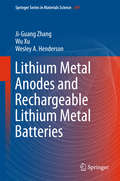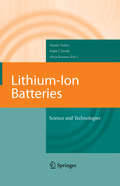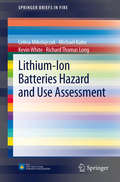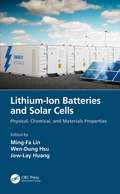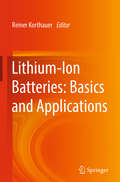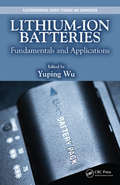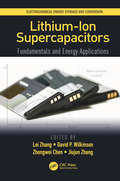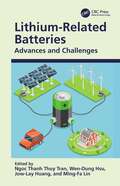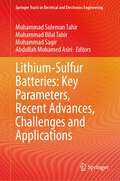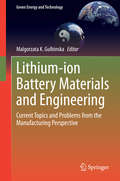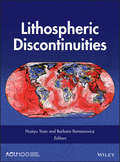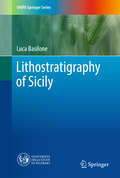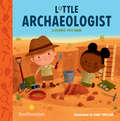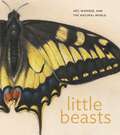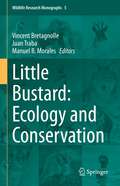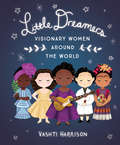- Table View
- List View
Literature and Science (Routledge Revivals)
by B. Ifor EvansFirst published in 1954, Literature and Science discusses historically the relationship between science and literature and between scientists and men of letters from the Renaissance onwards. It shows periods when writers were enthusiastic about science as in the early days of the Royal Society and notably through the influence of Newton. Further it explores the later alienation between science and literature in the technological and industrial age. There is a full account of Wordsworth’s crucial relationships to these problems which leads to a number of new conclusions. Apart from his historical survey, Dr. Ifor Evans emphasises the contemporary importance of the relationship of the artist and the scientist and outlines an approach to a new humanism, in which the writer may reach some closer understanding of science than he has at present attained. Students interested in literature, history of literature and critical theory will find this book enlightening.
Literature, Language, and the Rise of the Intellectual Disciplines in Britain, 1680–1820
by Robin ValenzaThe current divide between the sciences and the humanities, which often seem to speak entirely different languages, has its roots in the way intellectual disciplines developed in the long eighteenth century. As various fields of study became defined and to some degree professionalized, their ways of communicating evolved into an increasingly specialist vocabulary. Chemists, physicists, philosophers, and poets argued about whether their discourses should become more and more specialized, or whether they should aim to remain intelligible to the layperson. In this interdisciplinary study, Robin Valenza shows how Isaac Newton, Samuel Johnson, David Hume, Adam Smith, Samuel Taylor Coleridge and William Wordsworth invented new intellectual languages. By offering a much-needed new account of the rise of the modern disciplines, Robin Valenza shows why the sciences and humanities diverged so strongly, and argues that literature has a special role in navigating between the languages of different areas of thought.
Literature, Pedagogy, and Climate Change: Text Models for a Transcultural Ecology (Literatures, Cultures, and the Environment)
by Roman BartoschLiterature, Pedagogy, and Climate Change: Text Models for a Transcultural Ecology asks two questions: How do we read (in) the Anthropocene? And what can reading teach us? To answer these questions, the book develops a concept of transcultural ecology that understands fiction and interpretation as text models that help address the various and incommensurable scales inherent to climate change. Focussing on text composition, reception, storyworlds, and narrative framing in world literature and elsewhere, each chapter elaborates on central educational objectives through the close reading of texts by Chimamanda Ngozi Adichie, Teju Cole and J.M. Coetzee as well as films, picture books and new digital media and their aesthetic affordances. At the end of each chapter, these objectives are summarised in sections on the ‘general implications for studying and teaching’ (GIST) and together offer a new concept of transcultural competence in conversation with current debates in literature pedagogy and educational philosophy.
Lithic Technological Systems and Evolutionary Theory
by Nathan Goodale William Andrefsky Jr.Stone tool analysis relies on a strong background in analytical and methodological techniques. However, lithic technological analysis has not been well integrated with a theoretically-informed approach to understanding how humans procured, made, and used stone tools. Evolutionary theory has great potential to fill this gap. This collection of essays brings together several different evolutionary perspectives to demonstrate how lithic technological systems are a byproduct of human behavior. The essays cover a range of topics, including human behavioral ecology, cultural transmission, phylogenetic analysis, risk management, macroevolution, dual inheritance theory, cladistics, central place foraging, costly signaling, selection, drift, and various applications of evolutionary ecology.
Lithium Batteries: Advanced Technologies and Applications
by K. M. Abraham Walter Van Schalkwijk Jusef HassounExplains the current state of the science and points the way to technological advances First developed in the late 1980s, lithium-ion batteries now power everything from tablet computers to power tools to electric cars. Despite tremendous progress in the last two decades in the engineering and manufacturing of lithium-ion batteries, they are currently unable to meet the energy and power demands of many new and emerging devices. This book sets the stage for the development of a new generation of higher-energy density, rechargeable lithium-ion batteries by advancing battery chemistry and identifying new electrode and electrolyte materials. The first chapter of Lithium Batteries sets the foundation for the rest of the book with a brief account of the history of lithium-ion battery development. Next, the book covers such topics as: Advanced organic and ionic liquid electrolytes for battery applications Advanced cathode materials for lithium-ion batteries Metal fluorosulphates capable of doubling the energy density of lithium-ion batteries Efforts to develop lithium-air batteries Alternative anode rechargeable batteries such as magnesium and sodium anode systems Each of the sixteen chapters has been contributed by one or more leading experts in electrochemistry and lithium battery technology. Their contributions are based on the latest published findings as well as their own firsthand laboratory experience. Figures throughout the book help readers understand the concepts underlying the latest efforts to advance the science of batteries and develop new materials. Readers will also find a bibliography at the end of each chapter to facilitate further research into individual topics. Lithium Batteries provides electrochemistry students and researchers with a snapshot of current efforts to improve battery performance as well as the tools needed to advance their own research efforts.
Lithium Compounds in Organic Synthesis
by Vito Capriati Renzo LuisiThis unique book covers fundamentals of organolithium compounds and gives a comprehensive overview of the latest synthetic advances and developments in the field. Part I covers computational and spectroscopic aspects as well as structure-reactivity relationships of organolithiums, whereas Part II deals with new lithium-based synthetic methodologies as well as novel synthetic applications of functionalized lithium compounds. A useful resource for newcomers and active researchers involved in organic synthesis, whether working in academia or industry!
Lithium Intercalation in Bilayer Graphene Devices (Springer Theses)
by Matthias KühneThis book reports on the successful implementation of an innovative, miniaturized galvanic cell that offers unprecedented control over and access to ionic transport. It represents a milestone in fundamental studies on the diffusive transport of lithium ions between two atomically thin layers of carbon (graphene), a highly relevant aspect in electrodes for energy and mass storage in the context of batteries. Further, it is a beautiful example of how interdisciplinary work that combines expertise from two very distinct fields can significantly advance science. Machinery and tools common in the study of low-dimensional systems in condensed matter physics are combined with methods routinely employed in electrochemistry to enable truly unique and powerful experiments. The method developed here can easily be generalized and extended to other layered materials as well as other ionic species. Not only the method but also the outcome of its application to Li diffusion and intercalation in bilayer graphene is remarkable. A record chemical diffusion coefficient is demonstrated, exceeding even the diffusion of sodium chloride in water and surpassing any reported value of ion diffusion in single-phase mixed conducting materials. This finding may be indicative of the exceptional properties yet to be discovered in nanoscale derivatives of bulk insertion compounds.
Lithium Ion Glassy Electrolytes: Properties, Fundamentals, and Applications
by Sanjib Bhattacharya Koyel BhattacharyaThis book presents recent developments and future scopes of glassy systems, such as their electrical and optical properties, use as electrodes, photonics devices, battery applications and others, which are of great interest for material scientists and professionals. Each chapter is designed to increase coherence, containing examples and question sets as exercises for in-depth understanding of the text. It provides a valuable resource for researchers, professionals and students in the area of material research especially on Li-doped glasses.
Lithium Metal Anodes and Rechargeable Lithium Metal Batteries
by Ji-Guang Zhang Wu Xu Wesley A. HendersonThis book provides comprehensive coverage of Lithium (Li) metal anodes for rechargeable batteries. Li is an ideal anode material for rechargeable batteries due to its extremely high theoretical specific capacity (3860 mAh g-1), low density (0. 59 g cm-3), and the lowest negative electrochemical potential (−3. 040 V vs. standard hydrogenelectrodes). Unfortunately, uncontrollable dendritic Li growth and limited Coulombic efficiency during Li deposition/stripping inherent in these batteries have prevented their practical applications over the past 40 years. With the emergence of post Liion batteries, safe and efficient operation of Li metal anodes has become an enabling technology which may determine the fate of several promising candidates for the next generation energy storage systems, including rechargeable Li-air batteries, Li-S batteries, and Li metal batteries which utilize intercalation compounds as cathodes. In this work, various factors that affect the morphology and Coulombic efficiency of Li anodes are analyzed. The authors also present the technologies utilized to characterize the morphology of Li deposition and the results obtained by modeling of Li dendrite growth. Finally, recent developments, especially the new approaches that enable safe and efficient operation of Li metal anodes at high current densities are reviewed. The urgent need and perspectives in this field are also discussed. The fundamental understanding and approaches presented in this work will be critical for the application of Li metal anodes. The general principles and approaches can also be used in other metal electrodes and general electrochemical deposition of metal films.
Lithium-Ion Batteries
by Ralph J. Brodd Akiya Kozawa Masaki YoshioThis book is a compilation of up-to-date information relative to Li-Ion technology. It provides the reader with a single source covering all important aspects of Li-Ion battery operations. It fills the gap between the old original Li-Ion technology and present state of the technology that has developed into a high state of practice. The book is designed to provide a single source for an up-to-date description of the technology associated with the Li-Ion battery industry. It will be useful to researchers interested in energy conversion for the direct conversion of chemical energy into electrical energy as a textbook. University people will find a comprehensive description of the state-of-the-art of the Li-Ion system.
Lithium-Ion Batteries Hazard and Use Assessment
by Michael Kahn Richard Thomas Long Celina Mikolajczak Kevin WhiteLithium-Ion Batteries Hazard and Use Assessment examines the usage of lithium-ion batteries and cells within consumer, industrial and transportation products, and analyzes the potential hazards associated with their prolonged use. This book also surveys the applicable codes and standards for lithium-ion technology. Lithium-Ion Batteries Hazard and Use Assessment is designed for practitioners as a reference guide for lithium-ion batteries and cells. Researchers working in a related field will also find the book valuable.
Lithium-Ion Batteries and Solar Cells: Physical, Chemical, and Materials Properties
by Ming-Fa Lin Wen-Dung Hsu Jow-Lay HuangLithium-Ion Batteries and Solar Cells: Physical, Chemical, and Materials Properties presents a thorough investigation of diverse physical, chemical, and materials properties and special functionalities of lithium-ion batteries and solar cells. It covers theoretical simulations and high-resolution experimental measurements that promote a full understanding of the basic science to develop excellent device performance. Employs first-principles and the machine learning method to fully explore the rich and unique phenomena of cathode, anode, and electrolyte (solid and liquid states) in lithium-ion batteries Develops distinct experimental methods and techniques to enhance the performance of lithium-ion batteries and solar cells Reviews syntheses, fabrication, and measurements Discusses open issues, challenges, and potential commercial applications This book is aimed at materials scientists, chemical engineers, and electrical engineers developing enhanced batteries and solar cells for peak performance.
Lithium-Ion Batteries: Basics and Applications
by Reiner KorthauerThe handbook focuses on a complete outline of lithium-ion batteries. Just before starting with an exposition of the fundamentals of this system, the book gives a short explanation of the newest cell generation. The most important elements are described as negative / positive electrode materials, electrolytes, seals and separators. The battery disconnect unit and the battery management system are important parts of modern lithium-ion batteries. An economical, faultless and efficient battery production is a must today and is represented with one chapter in the handbook. Cross-cutting issues like electrical, chemical, functional safety are further topics. Last but not least standards and transportation themes are the final chapters of the handbook. The different topics of the handbook provide a good knowledge base not only for those working daily on electrochemical energy storage, but also to scientists, engineers and students concerned in modern battery systems.
Lithium-Ion Batteries: Fundamentals and Applications (Electrochemical Energy Storage And Conversion Ser. #4)
by Yuping WuLithium-Ion Batteries: Fundamentals and Applications offers a comprehensive treatment of the principles, background, design, production, and use of lithium-ion batteries. Based on a solid foundation of long-term research work, this authoritative monograph:Introduces the underlying theory and history of lithium-ion batteriesDescribes the key compone
Lithium-Ion Supercapacitors: Fundamentals and Energy Applications (Electrochemical Energy Storage and Conversion)
by Lei Zhang Jiujun Zhang Zhongwei Chen David P. WilkinsonThe book provides a comprehensive understanding of the principles for operating lithium-ion supercapacitors (LISCs), their challenges, technological trends and perspectives. LISC technology has high potential to replace conventional rechargeable batteries such as lead-acid and nickel metal hydride batteries for automotive, portable electronics, and stationary applications. The book offers detailed analysis of LISCs at the material, component, and system levels to evaluate the different approaches to their integration. It also discusses economics, market, manufacture, and commercialization status of LISCs. It is an up-to-date study of an emerging field, written by experts, ideal for those in academia and industry who want a detailed explanation of the technology.
Lithium-Related Batteries: Advances and Challenges
by Ngoc Thanh Thuy TranThis book serves as a comprehensive treatment of the advanced microscopic properties of lithium- and sodium-based batteries. It focuses on the development of the quasiparticle framework and the successful syntheses of cathode/electrolyte/anode materials in these batteries. FEATURES Highlights lithium-ion and sodium-ion batteries as well as lithium sulfur-, aluminum-, and iron-related batteries Describes advanced battery materials and their fundamental properties Addresses challenges to improving battery performance Develops theoretical predictions and experimental observations under a unified quasiparticle framework Targets core issues such as stability and efficiencies Lithium-Related Batteries: Advances and Challenges will appeal to researchers and advanced students working in battery development, including those in the fields of materials, chemical, and energy engineering.
Lithium-Sulfur Batteries: Key Parameters, Recent Advances, Challenges and Applications (Springer Tracts in Electrical and Electronics Engineering)
by Abdullah Mohamed Asiri Muhammad Sagir Muhammad Bilal Tahir Muhammad Suleman TahirThis book provides an excellent review and analysis of the latest information on rechargeable Li-S battery research. With a clear and concise writing style and in-depth technical material, this book will appeal to undergraduates and graduates, researchers, chemists, material scientists, and physicists working in the field of energy storage, especially those with an interest in Li-S battery technology. IEEE Electrical Insulation Magazine shows lithium-sulfur (Li-S) batteries give us an alternative to the more prevalent lithium-ion (Li-ion) versions and are known for their observed high-energy densities. Systems using Li-S batteries are in the early stages of development, and commercialization however could potentially provide higher, safer levels of energy at significantly lower cost. In this book, the history, scientific background, challenges, and future perspectives of the lithium-sulfur system are presented by experts in the field. Focus is on past and recent advances of each cell compartment responsible for the performance of the Li-S battery and includes analysis of characterization tools, new designs, and computational modeling. As a comprehensive review of the current state of play, it is ideal for undergraduates, graduate students, researchers, physicists, chemists, and materials scientists interested in energy storage, material science, and electrochemistry.
Lithium-ion Battery Materials and Engineering
by Malgorzata K. GulbinskaGaining public attention due, in part, to their potential application as energy storage devices in cars, Lithium-ion batteries have encountered widespread demand, however, the understanding of lithium-ion technology has often lagged behind production. This book defines the most commonly encountered challenges from the perspective of a high-end lithium-ion manufacturer with two decades of experience with lithium-ion batteries and over six decades of experience with batteries of other chemistries. Authors with years of experience in the applied science and engineering of lithium-ion batteries gather to share their view on where lithium-ion technology stands now, what are the main challenges, and their possible solutions. The book contains real-life examples of how a subtle change in cell components can have a considerable effect on cell's performance. Examples are supported with approachable basic science commentaries. Providing a unique combination of practical know-how with an in-depth perspective, this book will appeal to graduate students, young faculty members, or others interested in the current research and development trends in lithium-ion technology.
Lithospheric Discontinuities (Geophysical Monograph Series #239)
by Huaiyu Yuan Barbara RomanowiczA multidisciplinary update on continental plate tectonics and plate boundary discontinuities Understanding the origin and evolution of the continental crust continues to challenge Earth scientists. Lithospheric Discontinuities offers a multidisciplinary review of fine scale layering within the continental lithosphere to aid the interpretation of geologic layers. Once Earth scientists can accurately decipher the history, internal dynamics, and evolution of the continental lithosphere, we will have a clearer understanding of how the crust formed, how plate tectonics began, and how our continents became habitable. Volume highlights: Theories and observations of the current state of tectonic boundaries and discontinuities Contributions on field observations, laboratory experiments, and geodynamic predictions from leading experts in the field Mantle fabrics in response to various mantle deformation processes Insights on fluid distribution using geophysical observations, and thermal and viscosity constraints from dynamic modeling Discontinuities associated with lithosphere and lithosphere-asthenosphere boundary An integrated study of the evolving physical and chemical processes associated with lithosphere asthenosphere interaction Written for academic and researchgeoscientists, particularly in the field of tectonophysics, geophysicists, geodynamics, seismology, structural geology, environmental geology, and geoengineering, Lithospheric Discontinuities is a valuable resource that sheds light on the origin and evolution of plate interaction processes.
Lithostratigraphy of Sicily
by Luca BasiloneThis book offers as comprehensive an overview as possible of the lithostratigraphy of the Italian region of Sicily, taking into account the multiplicity of formational and terminological variability developed over more than a century of studies and publications. It presents stratigraphic terminology, the geological lexicon and the main stratigraphic subdivisions that are not familiar to Sicilian geologists. The new stratigraphic methods and the use of formations as mapping units have prompted the acquisition of new lithostratigraphic data, and a review of the previous units and their comparison with the new collected data, enabling the definition of a number of new lithostratigraphic units. The book summarizes the results in 77 worksheets containing the most important information regarding the lithological, sedimentological and microfacies characteristics, the measured thicknesses, areal extent and the regional aspects, the paleoenvironmental, paleogeographic and paleo-tectonics setting, compiled according to standard procedures and nomenclature rules provided by the International Commission on Stratigraphy (ICS).
Little Acorn Grows Up
by Edward GibbsLittle Acorn Grows Up is a sweet, simple tale that explores themes of growing up and nature from author/illustrator Edward Gibbs.In this companion book to Little Bee, Little Acorn proves that great things come in small packages as it grows from a tiny nut to a big tree that shelters its forest friends. Poignant and thoughtful, this book features Read Aloud functionality [where available].
Little Archaeologist (A Science Tots Book)
by Dan TaylorTeach your baby all about archaeologists with this new board book published in partnership with Smithsonian.Fossils. Shovels. Sieves. Brushes. These are all the important tools archaeologists use. In this new board book series published in conjunction with the Smithsonian Institute, young babies and toddlers will learn what an archaeologist does while enjoying playful art by Dan Taylor.
Little Beasts: Art, Wonder, and the Natural World
by Alexandra Libby Brooks Rich Stacey SellA richly illustrated look at the intersection of art and science in Renaissance EuropeArt played a pivotal role in the development of natural history during the sixteenth and seventeenth centuries. European colonial expansion enabled naturalists to study previously unknown insects, animals, and other beestjes—&“little beasts&”—from around the globe. Little Beasts explores how artists such as Joris Hoefnagel and Jan van Kessel helped deepen and spread knowledge of these creatures with highly detailed and playful works that inspired generations of printmakers, painters, decorative artists, and naturalists.This appealing book begins by mapping the origins of natural history as a discipline, showing how early illustrated treatises reflected a vibrant exchange between artists and naturalists that contributed to the growth of natural science and sparked public fascination with the animal kingdom. It shares insights into Hoefnagel&’s engagement with contemporary natural history, as demonstrated in his Four Elements—a four-volume series of some three hundred watercolor miniatures of animals—and examines how intaglio printmaking enabled natural history studies to reach new audiences. The volume concludes with a discussion of Van Kessel&’s small oil paintings, likely made for discerning collectors of both natural and artistic curiosities.Blending lively and informative essays with beautiful illustrations, Little Beasts traces the connections between artists, naturalists, and collectors in an age of scientific discovery and broadening horizons, inviting readers to look with wonder at nature&’s variety.Published in association with the National Gallery of Art, Washington, DCExhibition ScheduleNational Gallery of Art, Washington, DCMay 18–November 2, 2025
Little Bustard: Ecology and Conservation (Wildlife Research Monographs #5)
by Vincent Bretagnolle Juan Traba Manuel B. MoralesThis book is devoted to the Little Bustard, a medium sized Paleartic steppe bird whose distribution ranges from the Iberian Peninsula to Central Asia. At present, the European population is suffering a severe decline mainly due to agricultural intensification, although its status and concerns in non-European countries are relatively unknown. In spite of this dramatic situation, the Little Bustard is an interesting model species for topics as varied as phylogeny, life history evolution and demographic traits, sexual selection and lekking behavior, habitat selection, intra- and interspecific relationships, or interaction with farming and other anthropogenic disturbances. This book provides an updated, interdisciplinary, and worldwide review of the most recent information of this crucial species in the Palearctic steppe-bird community, from specific biological aspects and traits to research-focused management. Some of the most prominent scientists from different fields (systematics, breeding ecology, behavior, competence, predation, population dynamics, farming, conservation) update and synthesize the existing information on a singular, threatened and vulnerable species.
Little Dreamers: Visionary Women Around the World (Vashti Harrison)
by Vashti HarrisonFrom the New York Times bestselling author of Little Leaders: Bold Women in Black History comes the highly anticipated follow-up, a beautifully illustrated collectible detailing the lives of women creators around the world.Featuring the true stories of 40 women creators, ranging from writers to inventors, artists to scientists, Little Dreamers: Visionary Women Around the World inspires as it educates. Readers will meet trailblazing women like Mary Blair, an American modernist painter who had a major influence on how color was used in early animated films, actor/inventor Hedy Lamar, environmental activist Wangari Maathai, architect Zaha Hadid, filmmaker Maya Deren, and physicist Chien-Shiung Wu. Some names are known, some are not, but all of the women had a lasting effect on the fields they worked in.The charming, information-filled full-color spreads show the Dreamers as both accessible and aspirational so reader knows they, too, can grow up to do something amazing.
